Spatiotemporal Differentiation and Balance Pattern of Ecosystem Service Supply and Demand in the Yangtze River Economic Belt
Abstract
:1. Introduction
2. Materials and Methods
2.1. Research Area
2.2. Data Source
2.3. Research Method
2.3.1. Ecosystem Service Supply
2.3.2. Ecosystem Service Demand
2.3.3. Balance between the Supply and Demand of Ecosystem Services
2.3.4. Quantile Regression Analysis
3. Results
3.1. Changes of Land Use Types
3.2. Ecosystem Services Supply
3.3. Ecosystem Services Demand
3.4. Balace Pattern between the Supply and Demand of Ecosystem Services
3.5. The Relationship between the Spatial Pattern of the Supply and Demand of Ecosystem Services
4. Discussion
4.1. Deficiency and Prospect
4.2. Policy Enlightenment
5. Conclusions
Author Contributions
Funding
Institutional Review Board Statement
Informed Consent Statement
Data Availability Statement
Conflicts of Interest
References
- Daily, G.C. Nature’s Services: Societal Dependence on Natural Ecosystems; Island Press: Washington, DC, USA, 1997; pp. 2–7. [Google Scholar]
- Costanza, R.; D’Arge, R.; de Groot, R.; Farber, S.; Grasso, M.; Hannon, B.; Limburg, K.; Naeem, S.; O’Neill, R.V.; Paruelo, J.; et al. The value of the world’s ecosystem services and natural capital. Nature 1997, 387, 253–260. [Google Scholar] [CrossRef]
- Wang, J.; Lin, Y.; Zhai, T.; He, T.; Qi, Y.; Jin, Z.; Cai, Y. The role of human activity in decreasing ecologically sound land use in China. Land Degrad. Dev. 2018, 29, 446–460. [Google Scholar] [CrossRef]
- Shen, J.; Li, S.; Liang, Z.; Wang, Y.; Sun, F. Research progress and prospect for the relationships between ecosystem services supplies and demands. J. Nat. Resour. 2021, 36, 1909–1922. [Google Scholar] [CrossRef]
- Li, Z.; Li, S.; Cao, Y.; Wang, S.; Liu, S.; Zhang, Z. Supply and demand of ecosystem services: Basic connotation and practical application. J. Agric. Resour. Environ. 2022, 1, 1–16. [Google Scholar]
- Zhang, B.; Min, Q.; Jiao, W.; He, S.; Liu, M.; Yang, L. Research progress and perspective on ecosystem services trade-offs. Acta Ecol. Sin. 2021, 41, 5517–5532. [Google Scholar]
- Guo, C.; Xu, X.; Shu, Q. A review on the assessment methods of supply and demand of ecosystem services. Chin. J. Ecol. 2020, 39, 2086–2096. [Google Scholar]
- Wang, Z.; Peng, Y.; Xu, C. Current Applications and Future Potentials of Ecosystem Service Tradeoff Research. Acta Sci. Nat. Univ. Pekin. 2019, 55, 773–781. [Google Scholar]
- Wang, J.; Zhou, W. Ecosystem service flows: Recent progress and future perspectives. Acta Ecol. Sin. 2019, 39, 4213–4222. [Google Scholar]
- Ma, L.; Liu, H.; Peng, J.; Wu, J. A review of ecosystem services supply and demand. Acta Geogr. Sin. 2017, 72, 1277–1289. [Google Scholar]
- Yan, Y.; Zhu, J.; Wu, G.; Zhan, Y. Review and prospective applications of demand, supply, and consumption of ecosystem services. Acta Ecol. Sin. 2017, 37, 2489–2496. [Google Scholar]
- Wu, X.; Wang, W.; Li, H.; Tian, Y.; Ning, Z. Research and application of ecosystem service function supply and demand. Ecol. Econ. 2013, 2, 390–393. [Google Scholar]
- Zhang, Y. Some Basic Issues in Ecosystem Services Research. Resour. Sci. 2012, 34, 725–733. [Google Scholar]
- Yi, D.; Xiao, S.; Han, Y.; Ou, M. Review on supply and demand of ecosystem service and the construction of systematic frame-work. Chin. J. Appl. Ecol. 2021, 32, 3942–3952. [Google Scholar]
- Bai, Y.; Wang, M.; Li, H.; Huang, S.; Alatalo, J.M. Ecosystem service supply and demand: Theory and management application. Acta Ecol. Sin. 2017, 37, 5846–5852. [Google Scholar]
- Ding, Z.; Yao, S. Rationality and Decision-making Attributes of Sensitivity Coefficient of Ecosystem Services Based on Elastic Model. Sci. Geogr. Sin. 2019, 39, 1672–1679. [Google Scholar]
- Zhao, Z.; Yu, D.; Wang, K.; LV, A. Ecosystem services value evaluation and strategies of payment for ecosystem service in western Jiangxi Province. Acta Ecol. Sin. 2020, 40, 7507–7518. [Google Scholar]
- Deng, J.; Chang, L.; Zhang, Y.; Zhou, W.; Qi, L.; Zhou, L.; Yu, D. Accounting of gross ecosystem product in Fuzhou City, China. Chin. J. Appl. Ecol. 2021, 1, 1–12. [Google Scholar]
- Yin, N.; Wang, S.; Liu, Y. Ecosystem service value assessment: Research progress and prospects. Chin. J. Ecol. 2021, 40, 233–244. [Google Scholar]
- Liu, Y.; Ren, Y.; Zhou, Y.; Liu, C. Dynamic simulation of ecosystem service value in Jianghan Plain Based on Ca Markov-a case study of Qianjiang City, Hubei Province. Chin. J. Agric. Resour. Reg. Plan. 2020, 41, 159–167. [Google Scholar]
- Gao, X.; Wan, Y.; Li, C.; Song, Z.; Wang, J. Land use change and ecosystem service value measurement in Baiyangdian Basin under the simulated multiple scenarios. Acta Ecol. Sin. 2021, 41, 7974–7988. [Google Scholar]
- Lin, M.; Liu, H.; Zhou, R.; Gong, J. Evaluation and trade-offs of ecosystem services in GuangdongHong Kong-Macao Greater Bay Area under multi-scenario simulation. Geogr. Res. Aust. 2021, 40, 2657–2669. [Google Scholar]
- Wang, R.; Pan, H.; Liu, Y.; Tang, Y.; Zhang, Z.; Ma, H. Evolution and driving force of ecosystem service value based on dynamic equivalent in Leshan City. Acta Ecol. Sin. 2022, 1, 1–14. [Google Scholar]
- Geng, T.; Hai, C.; Zhang, X.; Shi, Q.; Liu, D. Spatiotemporal evolution of land ecosystem service value and its influencing factors in Shaanxi province based on GWR. J. Nat. Resour. 2020, 35, 1714–1727. [Google Scholar]
- Chen, X.; Wang, X.; Feng, X.; Zhang, X.; Luo, G. Ecosystem service trade-off and synergy on Qinghai-Tibet Plateau. Geogr. Res. Aust. 2021, 40, 18–34. [Google Scholar]
- Li, D.; Zhang, X.; Wang, Y.; Zhang, X.; Li, L.; Lu, L. Evolution process of ecosystem services and the trade-off synergy in Xin’an River Basin. Acta Ecol. Sin. 2021, 17, 1–13. [Google Scholar]
- Qiu, J.; Liu, Y.; Yuan, L.; Chen, C.; Huang, Q. Research progress and prospect of the interrelationship between ecosystem services and human well-being in the context of coupled human and natural system. Prog. Geogr. 2021, 40, 1060–1072. [Google Scholar] [CrossRef]
- Cheng, X.; Tao, Y.; Ou, W. Research Progress on the Relationship between Ecosystem Service and Human Well-being. J. Ecol. Rural Environ. 2021, 37, 885–893. [Google Scholar]
- Chen, Y.; Tan, Y.; Qiu, X.; Song, X.; Zhou, Z.; Wan, R. Spatial transfer of ecosystem services in urban agglomeration of Yangtze River Delta under the relationship of supply and demand. J. Huaqiao Univ. 2022, 1, 1–9. [Google Scholar]
- Chen, Y.; Chen, Z.; Li, F.; Huang, Q. Study on Balance between Supply and Demand of Ecological Space in the Yangtze River Delta in Combination with Spatial Statistical Features. Areal Res. Dev. 2022, 41, 13–19. [Google Scholar]
- Li, C.; Zhao, J. Study on supply and demand pattern and influencing factors of ecosystem services in urban agglomeration of Yangtze River Delta. Ecol. Econ. 2022, 1, 1–20. [Google Scholar]
- Capriolo, A.; Boschetto, R.G.; Mascolo, R.A.; Balbi, S.; Villa, F. Biophysical and economic assessment of four ecosystem services for natural capital accounting in Italy. Ecosyst. Serv. 2020, 46, 101207. [Google Scholar] [CrossRef]
- Serna-Chavez, H.M.; Schulp, C.J.E.; van Bodegom, P.M.; Bouten, W.; Verburg, P.H.; Davidson, M.D. A quantitative framework for assessing spatial flows of ecosystem services. Ecol. Indic. 2014, 39, 24–33. [Google Scholar] [CrossRef] [Green Version]
- Nedkov, S.; Burkhard, B. Flood regulating ecosystem services—Mapping supply and demand, in the Etropole municipality, Bulgaria. Ecol. Indic. 2012, 21, 67–79. [Google Scholar] [CrossRef]
- Stürck, J.; Poortinga, A.; Verburg, P.H. Mapping ecosystem services: The supply and demand of flood regulation services in Europe. Ecol. Indic. 2014, 38, 198–211. [Google Scholar] [CrossRef]
- Dong, X.; Zhaojun, W.; Yuan, L.; Mengxue, L.; Hejie, W. Assessment of Ecosystem Services Supply and Demand (Mis)matches for Urban Ecological Management: A Case Study in the Zhengzhou–Kaifeng–Luoyang Cities. Remote Sens. 2022, 14, 1703. [Google Scholar]
- Li, J. Identification of ecosystem services supply and demand and driving factors in Taihu Lake Basin. Environ. Sci. Pollut. Res. 2022, 29, 29735–29745. [Google Scholar] [CrossRef]
- Palomo, I.; Martín-López, B.; Potschin, M.; Haines-Young, R.; Montes, C. National Parks, buffer zones and surrounding lands: Mapping ecosystem service flows. Ecosyst. Serv. 2013, 4, 104–116. [Google Scholar] [CrossRef]
- Xiao, P.; Zhou, Y.; Li, M.; Xu, J. Spatiotemporal patterns of habitat quality and its topographic gradient effects of Hubei Province based on the InVEST model. Environ. Dev. Sustain. 2022. [Google Scholar] [CrossRef]
- Babbar, D.; Areendran, G.; Sahana, M.; Sarma, K.; Raj, K.; Sivadas, A. Assessment and prediction of carbon sequestration using Markov chain and InVEST model in Sariska Tiger Reserve, India. J. Clean. Prod. 2021, 278, 123333. [Google Scholar] [CrossRef]
- Jiang, J.; Wu, W. Spatio-temporal evolution of habitat quality in Guangdong-Hong Kong-Macao Greater Bay Area based on regional GDP and population spatial distribution. Acta Ecol. Sin. 2021, 41, 1747–1757. [Google Scholar]
- Wu, L.; Sun, C.; Fan, F. Estimating the Characteristic Spatiotemporal Variation in Habitat Quality Using the InVEST Model—A Case Study from Guangdong–Hong Kong–Macao Greater Bay Area. Remote Sens. 2021, 13, 1008. [Google Scholar] [CrossRef]
- Bagstad, K.J.; Reed, J.M.; Semmens, D.J.; Sherrouse, B.C.; Troy, A. Linking biophysical models and public preferences for ecosystem service assessments: A case study for the Southern Rocky Mountains. Reg. Environ. Change 2016, 16, 2005–2018. [Google Scholar] [CrossRef]
- Willcock, S.; Martínez-López, J.; Hooftman, D.A.P.; Bagstad, K.J.; Balbi, S.; Marzo, A.; Prato, C.; Sciandrello, S.; Signorello, G.; Voigt, B.; et al. Machine learning for ecosystem services. Ecosyst. Serv. 2018, 33, 165–174. [Google Scholar] [CrossRef]
- Wang, J.; Zhai, T.; Lin, Y.; Kong, X.; He, T. Spatial imbalance and changes in supply and demand of ecosystem services in China. Sci. Total Environ. 2019, 657, 781–791. [Google Scholar] [CrossRef]
- Tian, P.; Li, J.; Cao, L.; Pu, R.; Gong, H.; Zhang, H.; Chen, H.; Yang, X. Assessing Matching Characteristics and Spatial Differences between Supply and Demand of Ecosystem Services: A Case Study in Hangzhou, China. Land 2021, 10, 582. [Google Scholar] [CrossRef]
- Liu, J.; Jing, W.; Dai, J.; Zhai, T.; Li, Z. The relationship between supply and demand of ecosystem services and its spatio-temporal variation in the Yellow River Basin. J. Nat. Resour. 2021, 36, 148–161. [Google Scholar] [CrossRef]
- Peng, J.; Yang, M.; Xie, P.; Liu, Y. Zoning for the construction of green space ecological networks in Guangdong Province based on the supply and demand of ecosystem services. Acta Ecol. Sin. 2017, 37, 4562–4572. [Google Scholar]
- Zhang, P.; Zhu, X.; He, Q.; Ouyang, X. Analysis on the spatial-temporal differentiation and supply-demand balance pattern of ecosystem services in the Yangtze River Economic Zone. Ecol. Sci. 2020, 39, 155–166. [Google Scholar]
- Shou, F.; Li, Z.; Huang, L.; Huang, S.; Yan, L. Spatial differentiation and ecological patterns of urban agglomeration based on evaluations of supply and demand of ecosystem services: A case study on the Yangtze River Delta. Acta Ecol. Sin. 2020, 40, 2813–2826. [Google Scholar]
- Rong, Y.; Yan, Y.; Zhao, C.; Zhu, J.; Zheng, T.; Wang, C.; Lu, H.; Zhang, W. Multi-scale characteristics of landsenses ecology and its application based on supply and demand of ecosystem services. Acta Ecol. Sin. 2020, 40, 8034–8043. [Google Scholar]
- Hu, Q.; Chen, S. Optimizing the ecological networks based on the supply and demand of ecosystem services in Xiamen-Zhangzhou-Quanzhou region. J. Nat. Resour. 2021, 36, 342–355. [Google Scholar] [CrossRef]
- Meng, Q.; Zhang, L.; Wei, H.; Cai, E.; Dong, X. Spatio-temporal evolution of the supply and demand risk of ecosystem services in the Yihe River Basin based on LUCC. Acta Ecol. Sin. 2022, 42, 2033–2049. [Google Scholar]
- Wang, M.; Bai, Z.; Dong, X. Land Consolidation Zoning in Shaanxi Province based on the Supply and Demand of Ecosystem Services. China Land Sci. 2018, 32, 73–80. [Google Scholar] [CrossRef] [Green Version]
- Xiao, P.; Zhao, C.; Zhou, Y.; Feng, H.; Li, X.; Jiang, J. Study on Land Consolidation Zoning in Hubei Province Based on the Coupling of Neural Network and Cluster Analysis. Land 2021, 10, 756. [Google Scholar] [CrossRef]
- Zhou, Z.; Liu, D. Zoning of the ecosystem service functions under multiple land consolidation scenarios. Trans. Chin. Soc. Agric. Eng. 2021, 37, 262–270. [Google Scholar]
- Chen, Y.; Wang, X.; Zhen, N.; Zhang, G.; Guo, Y.; Li, Z.; Ren, H. Practice of ecological protection and restoration of mountain-river-forest-farmland-lake-grassland based on connotation of ecosystem service theory:taking the pilot project of South-Taihang Area in Henan Province as an example. J. Environ. Eng. Technol. 2021, 11, 701–710. [Google Scholar]
- Jing, Y.; Chen, L.; Sun, R. A theoretical research framework for ecological security pattern construction based on ecosystem services supply and demand. Acta Ecol. Sin. 2018, 38, 4121–4131. [Google Scholar]
- Zhang, D.; Qu, L.; Zhang, J. Ecological security pattern construction method based on the perspective of ecological supply and demand: A case study of Yangtze River Delta. Acta Ecol. Sin. 2019, 39, 7525–7537. [Google Scholar]
- Guan, Q.; Hao, J.; Xu, Y.; Ren, G.; Kang, L. Zoning of agroecological management based on the relationship between supply and demand of ecosystem services. Resour. Sci. 2019, 41, 1359–1373. [Google Scholar]
- Rong, Y.; Yan, Y.; Wang, C.; Zhang, W.; Zhu, J.; Lu, H.; Zheng, T. Construction and optimization of ecological network in Xiong’an New Area based on the supply and demand of ecosystem services. Acta Ecol. Sin. 2020, 40, 7197–7206. [Google Scholar]
- Xie, Y.; Zhang, S.; Lin, B.; Zhao, Y.; Hu, B. Spatial zoning for land ecological consolidation in Guangxi based on the ecosystem services supply and demand. J. Nat. Resour. 2020, 35, 217–229. [Google Scholar]
- Han, Z.; Liu, C.; Yan, X.; Li, X.; Wang, X. Coupling coordination and matches in ecosystem services supply-demand for ecological zoning management:A case study of Dalian. Acta Ecol. Sin. 2021, 41, 9064–9075. [Google Scholar]
- Cao, J.; Wang, L.; Cao, W. Research on Ecological Zoning Based on the Differential Pattern of Ecosystem Service Supply and Demand—Taking Nanjing Metropolitan Area as an Example. Resour. Dev. Mark. 2022, 1, 1–12. [Google Scholar]
- Pablo, H.; Timon, M. Mapping supply of and demand for ecosystem services to assess environmental justice in New York City. Ecol. Appl. Publ. Ecol. Soc. Am. 2021, 31, 101081. [Google Scholar]
- Yang, M.; Zhao, X.; Wu, P.; Hu, P.; Gao, X. Quantification and spatially explicit driving forces of the incoordination between ecosystem service supply and social demand at a regional scale. Ecol. Indic. 2022, 137, 108764. [Google Scholar] [CrossRef]
- Zhao, Y.; Wang, N.; Luo, Y.; He, H.; Wu, L.; Wang, H.; Wang, Q.; Wu, J. Quantification of ecosystem services supply-demand and the impact of demographic change on cultural services in Shenzhen, China. J. Environ. Manag. 2022, 304, 114280. [Google Scholar] [CrossRef]
- Jiang, M.; Jiang, C.; Huang, W.; Chen, W.; Gong, Q.; Yang, J.; Zhao, Y.; Zhuang, C.; Wang, J.; Yang, Z. Quantifying the supply-demand balance of ecosystem services and identifying its spatial determinants: A case study of ecosystem restoration hotspot in Southwest China. Ecol. Eng. 2022, 174, 106472. [Google Scholar] [CrossRef]
- Zou, Y.; Mao, D. Simulation of Freshwater Ecosystem Service Flows under Land-Use Change: A Case Study of Lianshui River Basin, China. Sustainability 2022, 14, 3270. [Google Scholar] [CrossRef]
- Xu, Z.; Peng, J.; Dong, J.; Liu, Y.; Liu, Q.; Lyu, D.; Qiao, R.; Zhang, Z. Spatial correlation between the changes of ecosystem service supply and demand: An ecological zoning approach. Landsc. Urban Plan 2022, 217, 104258. [Google Scholar] [CrossRef]
- Chen, W.; Chi, G. Spatial mismatch of ecosystem service demands and supplies in China, 2000−2020. Environ. Monit. Assess. 2022, 194, 1–18. [Google Scholar] [CrossRef]
- Zhai, T.; Jing, W.; Jin, Z.; Qi, Y. Change and correlation analysis of the supply-demand pattern of ecosystem services in the Yangtze River Economic Belt. Acta Ecol. Sin. 2019, 39, 5414–5424. [Google Scholar]
- The State Council Guiding Opinions of the State Council on Relying on the Golden Waterway to Promote the Development of the Yangtze River Economic Belt. Available online: http://www.gov.cn/zhengce/content/2014−09/25/content_9092.htm (accessed on 6 September 2021).
- Deng, C.; Long, Z.X.; Xie, B.; Wan, Y.; Song, X. Spatial and temporal changes of land ecosystem service value in Dongting Lake area in 1995−2015. Geogr. Res. 2019, 38, 844–855. [Google Scholar]
- Zhang, X.; Wang, X.; Cheng, C.; Liu, S.; Zhou, C. Ecosystem service flows in Karst area of China based on the relationship between supply and demand. Acta Ecol. Sin. 2021, 41, 3368–3380. [Google Scholar]
- Xie, G.; Zhang, C.; Zhang, L.; Chen, W.; Li, S. Improvement of the Evaluation Method for Ecosystem Service Value Based on Per Unit Area. J. Nat. Resour. 2015, 30, 1243–1254. [Google Scholar]
- Huang, Y.; Liang, Z.; Wang, Y.; Wang, Y.; Wang, B.; Gu, J.; Li, Y. Study on the applicability of ecological service value equivalent method—A case study of small watershed in typical karst area of Guangxi. Soil Water Conserv. China 2020, 1, 43–47. [Google Scholar]
- Yang, M.; Wang, S.; Zhou, Y.; Wang, L. A Method of Urbanization Level Estimation Using DMSP/OLS Imagery. Remote Sens. Inf. 2011, 26, 100–106. [Google Scholar]
- Jia, Y.; Qin, K. GDP forecast analysis of Guangxi coastal area based on DMSP/OLS night light data. Cities Towns Constr. Guangxi 2021, 1, 8–12. [Google Scholar]
- Liu, D.; Feng, Z.; Yang, Y. Ecological Balance between Supply and Demand in China Using Ecological Footprint Method. J. Nat. Resour. 2012, 27, 614–624. [Google Scholar]
- Ou, W.; Wang, H.; Tao, Y. A land cover-based assessment of ecosystem services supply and demand dynamics in the Yangtze River Delta region. Acta Ecol. Sin. 2018, 38, 6337–6347. [Google Scholar]
- Moutinho, V.; Madaleno, M.; Robaina, M. The economic and environmental efficiency assessment in EU cross-country: Evidence from DEA and quantile regression approach. Ecol. Indic. 2017, 78, 85–97. [Google Scholar] [CrossRef]
- Gu, K.; Yang, Q.; Cheng, F.; Chu, J.; Chen, X. Spatial Differentiation of Anhui Province Based on the Relationship Between Supply and Demand of Ecosystem Services. J. Ecol. Rural Environ. 2018, 34, 577–583. [Google Scholar]
- Burkhard, B.; Kroll, F.; Nedkov, S.; Müller, F. Mapping ecosystem service supply, demand and budgets. Ecol. Indic. 2012, 21, 17–29. [Google Scholar] [CrossRef]
- Sun, R.; Jin, X.; Han, B.; Liang, X.; Zhang, X.; Zhou, Y. Does scale matter? Analysis and measurement of ecosystem service supply and demand status based on ecological unit. Environ. Impact Asses. Rev. 2022, 95, 106785. [Google Scholar] [CrossRef]
- Gonzalez-Garcia, A.; Palomo, I.; Gonzalez, J.A.; García-Díez, V.; García-Llorente, M.; Montes, C. Biodiversity and ecosystem services mapping: Can it reconcile urban and protected area planning? Sci. Total Environ. 2022, 803, 150048. [Google Scholar] [CrossRef]
- Rumana, S.; Ahmed, S.S.; Shafiul, A.M. Diverse perceptions of supply and demand of cultural ecosystem services offered by urban green spaces in Dhaka, Bangladesh. J. Urban Ecol. 2022, 8, juac003. [Google Scholar]
- Azam, K.M.; Mohsen, S. Investigating tradeoffs between supply, use and demand of ecosystem services and their effective drivers for sustainable environmental management. J. Environ. Manag. 2021, 289, 112534. [Google Scholar]
- Wei, S.; Kexin, W.; Yong, D.; Haifeng, Y. The Trade-Offs between Supply and Demand Dynamics of Ecosystem Services in the Bay Areas of Metropolitan Regions: A Case Study in Quanzhou, China. Land 2021, 11, 22. [Google Scholar]
- Zhao, X.; Su, J.; Wang, J.; Jin, W.; Chen, E.; Zhang, J.; Xiang, M. A study on the relationship between supply-demand relationship of ecosystem services and impact factors in Gansu Province. China Environ. Sci. 2021, 1, 1–18. [Google Scholar]
- Xiang, H.; Zhang, J.; Mao, D.; Wang, Z.; Qiu, Z.; Yan, H. Identifying spatial similarities and mismatches between supply and demand of ecosystem services for sustainable Northeast China. Ecol. Indic. 2022, 134, 108501. [Google Scholar] [CrossRef]
- Cai, W.; Jiang, W.; Du, H.; Chen, R.; Cai, Y. Assessing Ecosystem Services Supply-Demand (Mis)Matches for Differential City Management in the Yangtze River Delta Urban Agglomeration. Int. J. Environ. Res. Public Health 2021, 18, 8130. [Google Scholar] [CrossRef]
- Luo, C.; Li, X. Assessment of Ecosystem Service Supply, Demand, and Balance of Urban Green Spaces in a Typical Mountainous City: A Case Study on Chongqing, China. Int. J. Environ. Res. Public Health 2021, 18, 11002. [Google Scholar] [CrossRef] [PubMed]
- Li, P.; Liu, C.; Liu, L.; Wang, W. Dynamic Analysis of Supply and Demand Coupling of Ecosystem Services in Loess Hilly Region: A Case Study of Lanzhou, China. Chin. Geogr. Sci. 2021, 31, 276–296. [Google Scholar] [CrossRef]
- Enrica, G.; Josep, P.; Ribas, P.A.; Josep, V. Follow the flow: Analysis of relationships between water ecosystem service supply units and beneficiaries. Appl. Geogr. 2021, 133, 102491. [Google Scholar]
- Zhai, T.; Zhang, D.; Zhao, C. How to optimize ecological compensation to alleviate environmental injustice in different cities in the Yellow River Basin? A case of integrating ecosystem service supply, demand and flow. Sustain. Cities Soc. 2021, 75, 103341. [Google Scholar] [CrossRef]
- Xin, R.; Hans, S.; Zeng, J.; Zhou, J.; Li, K.; Hu, J.; Liu, X.; Kong, J.; Wang, Q. Identifying key areas of imbalanced supply and demand of ecosystem services at the urban agglomeration scale: A case study of the Fujian Delta in China. Sci. Total Environ. 2021, 791, 148173. [Google Scholar] [CrossRef]
- Lei, S.; Ümüt, H.; Zulpiya, M.; Aishan, T.; Martin, W. Identifying Mismatches of Ecosystem Services Supply and Demand under semi-arid conditions: The Case of the Oasis City Urumqi, China. Integr. Environ. Assess. 2021, 17, 1293–1304. [Google Scholar]
- Yue, W.; Hou, L.; Xia, H.; Wei, J.; Lu, Y. Territorially ecological restoration zoning and optimization strategy in Guyuan City of Ningxia, China: Based on the balance of ecosystem service supply and demand. J. Appl. Ecol. 2022, 33, 149–158. [Google Scholar]
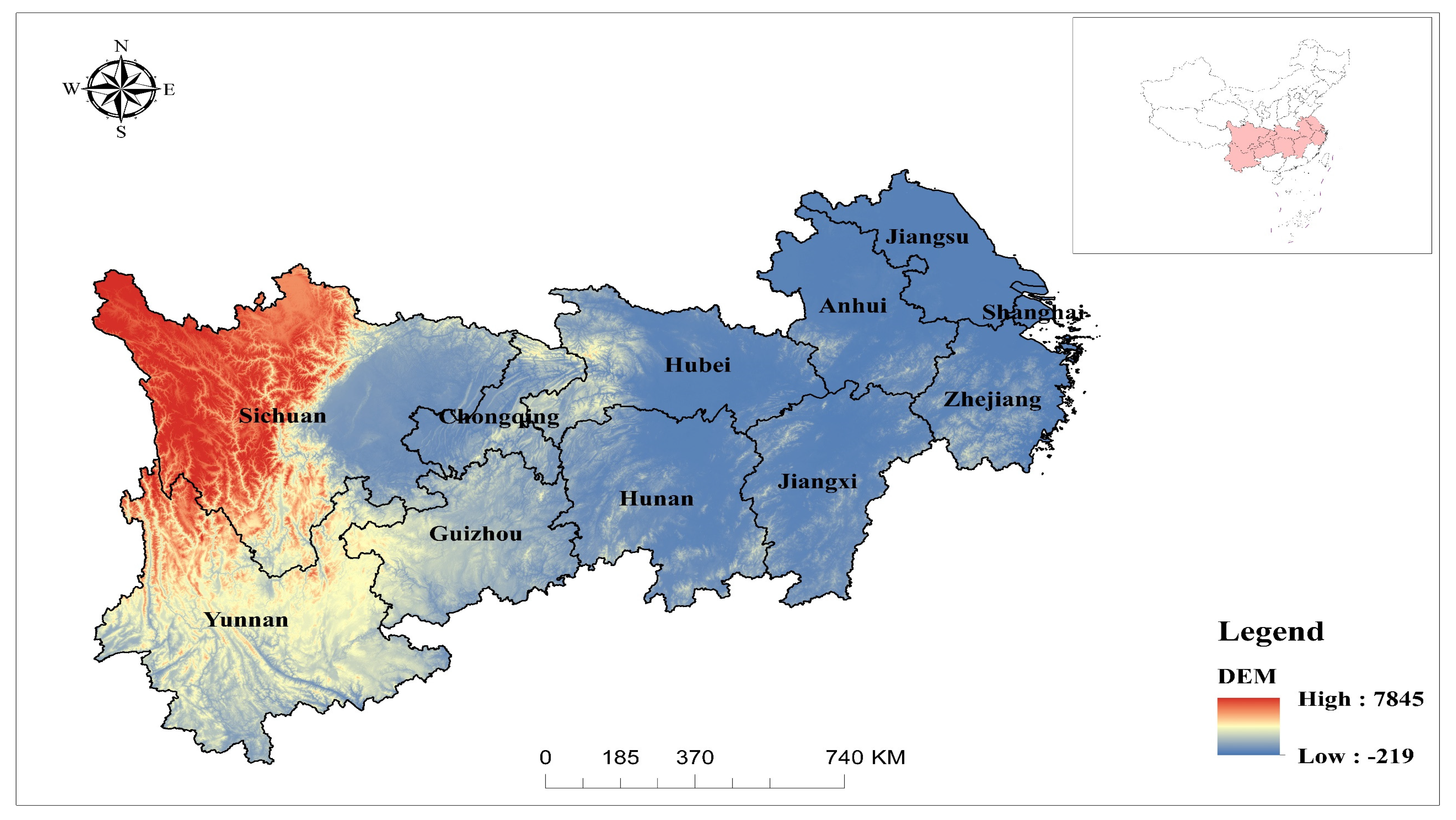
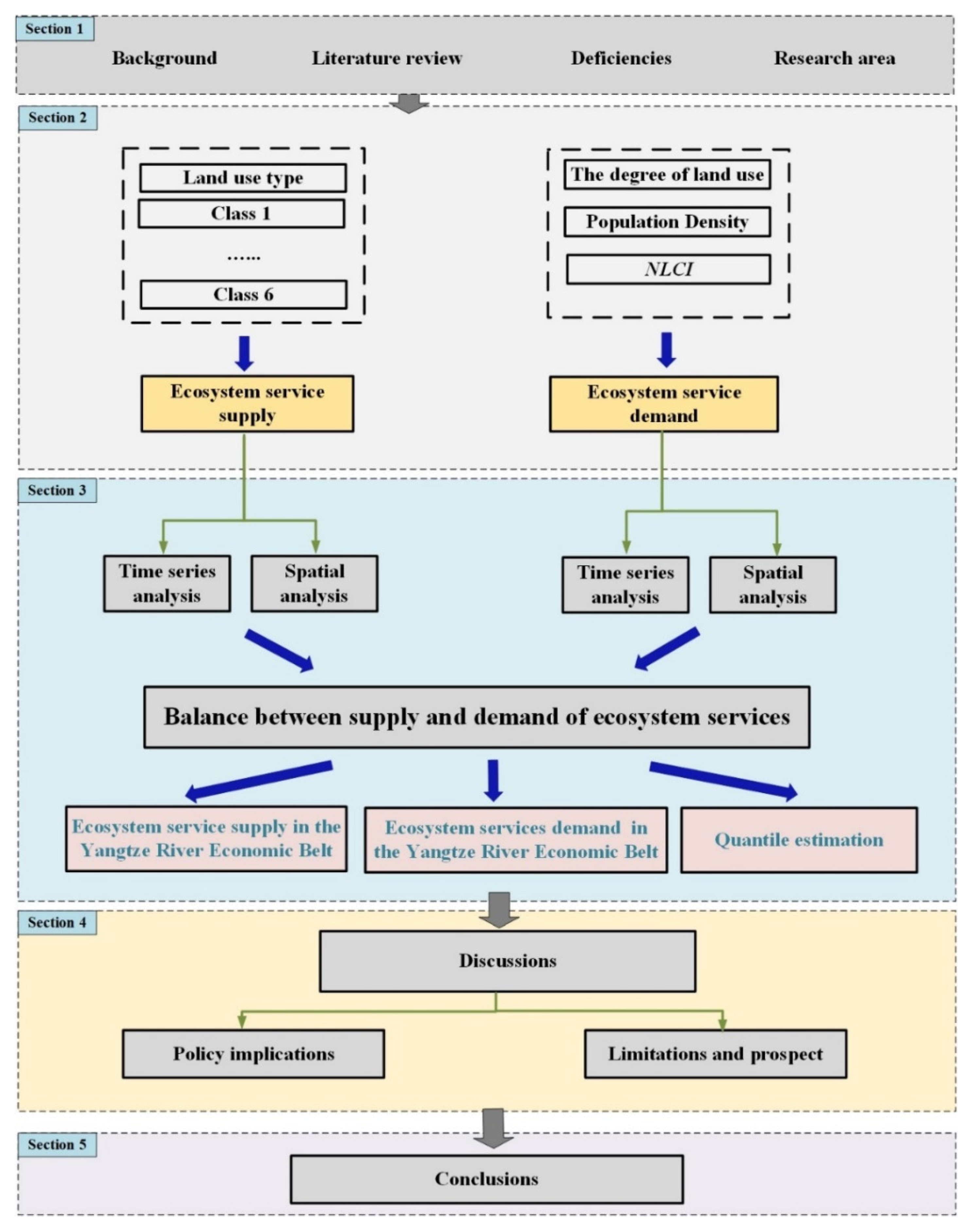
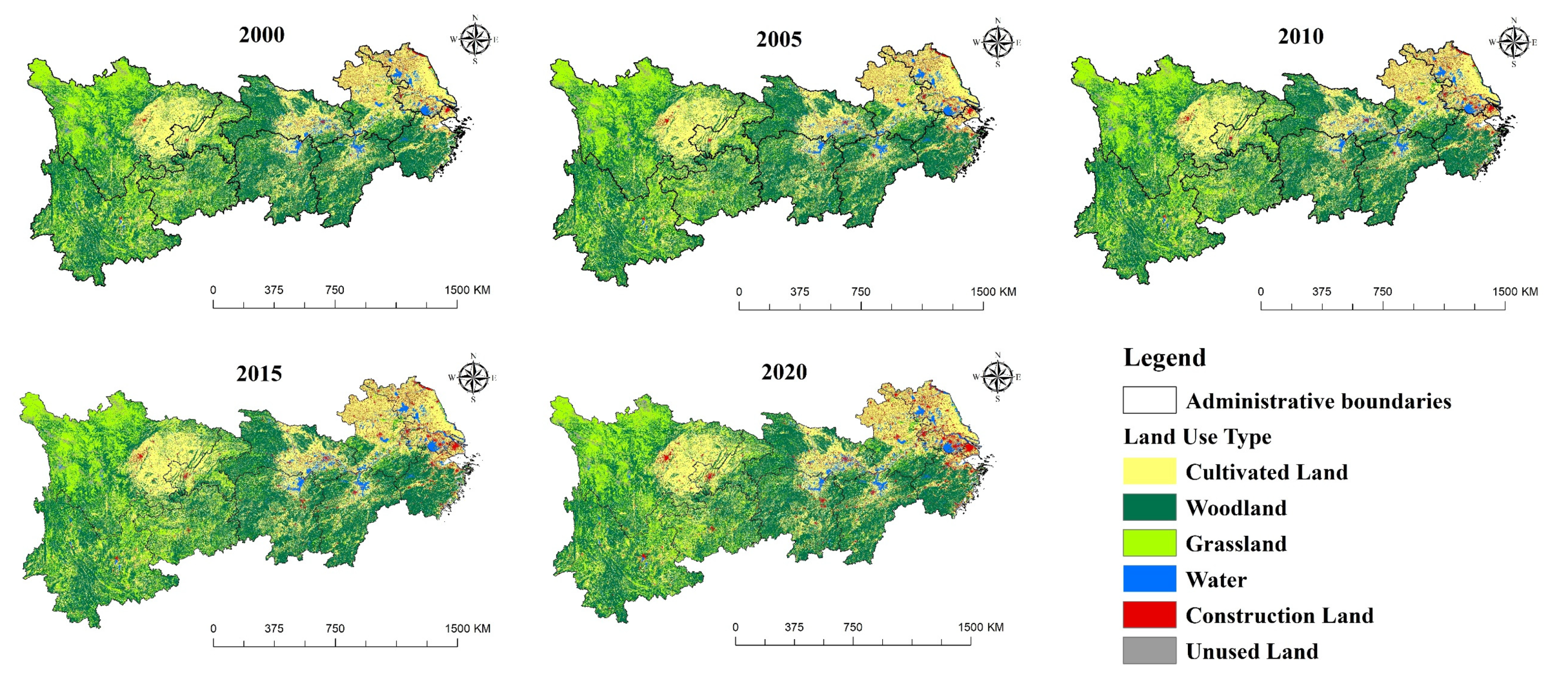
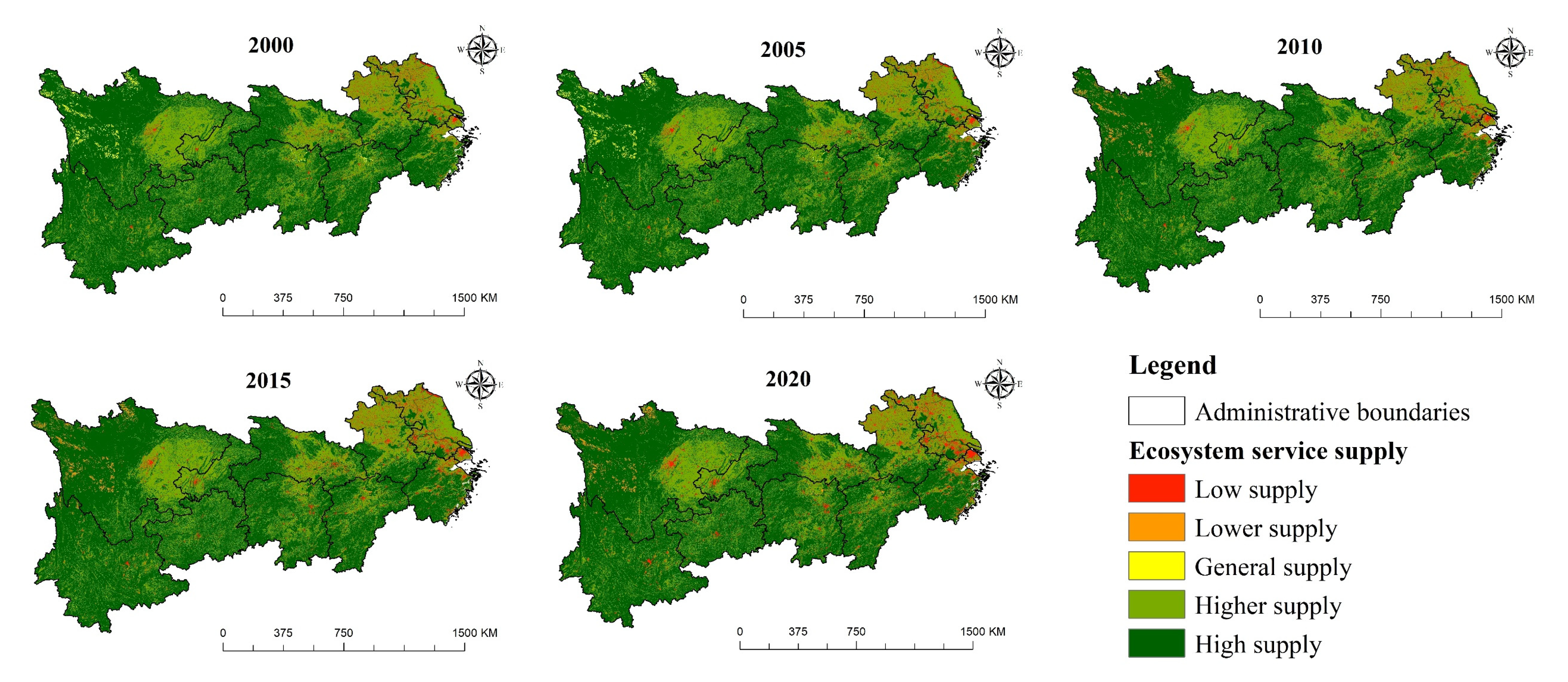
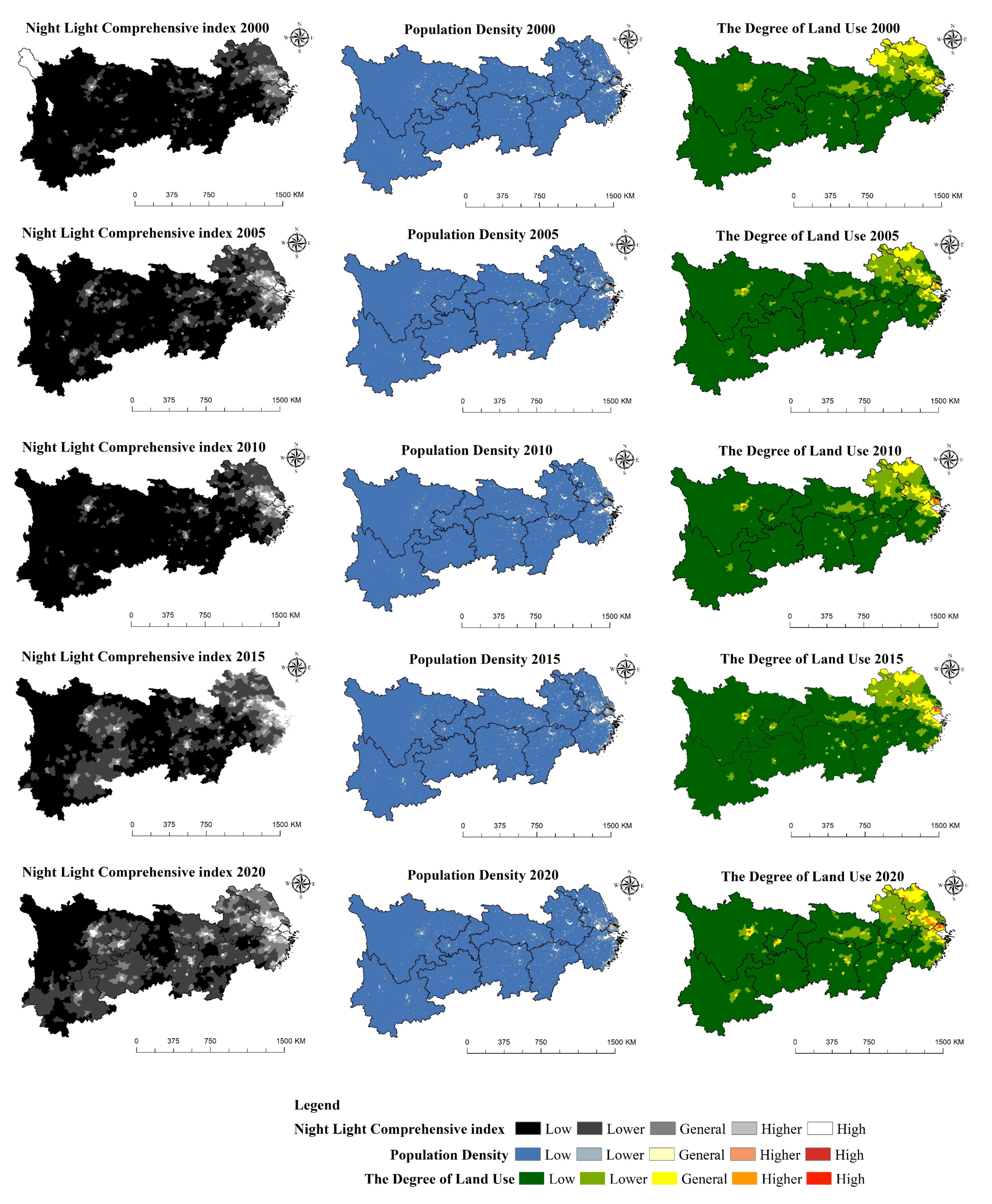
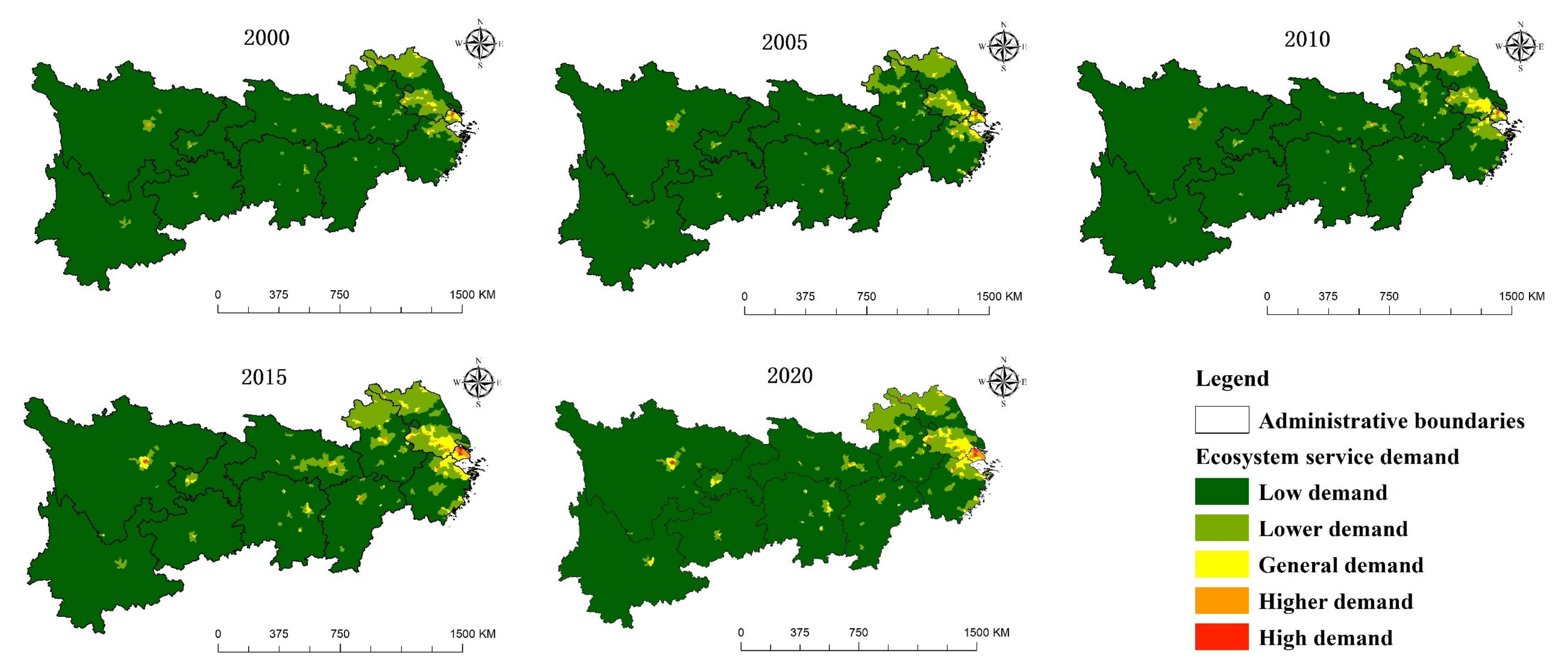
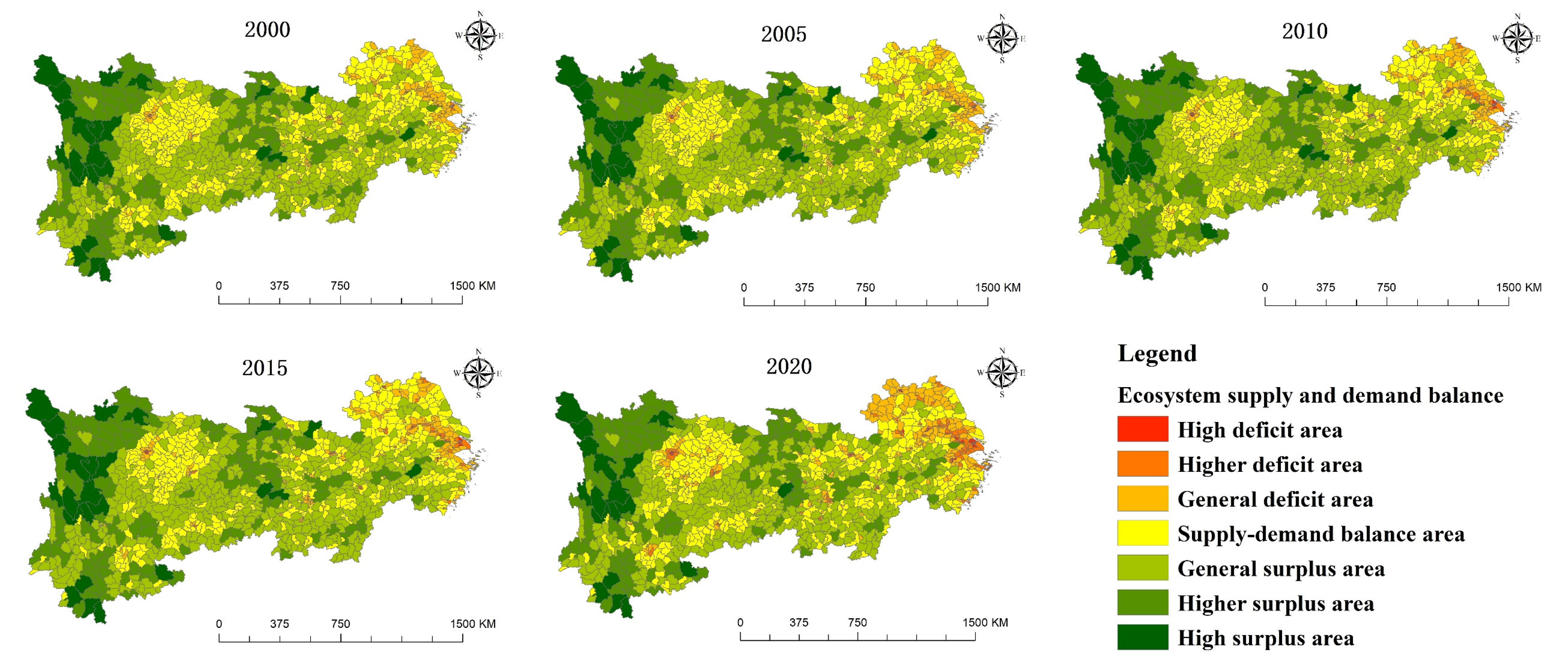
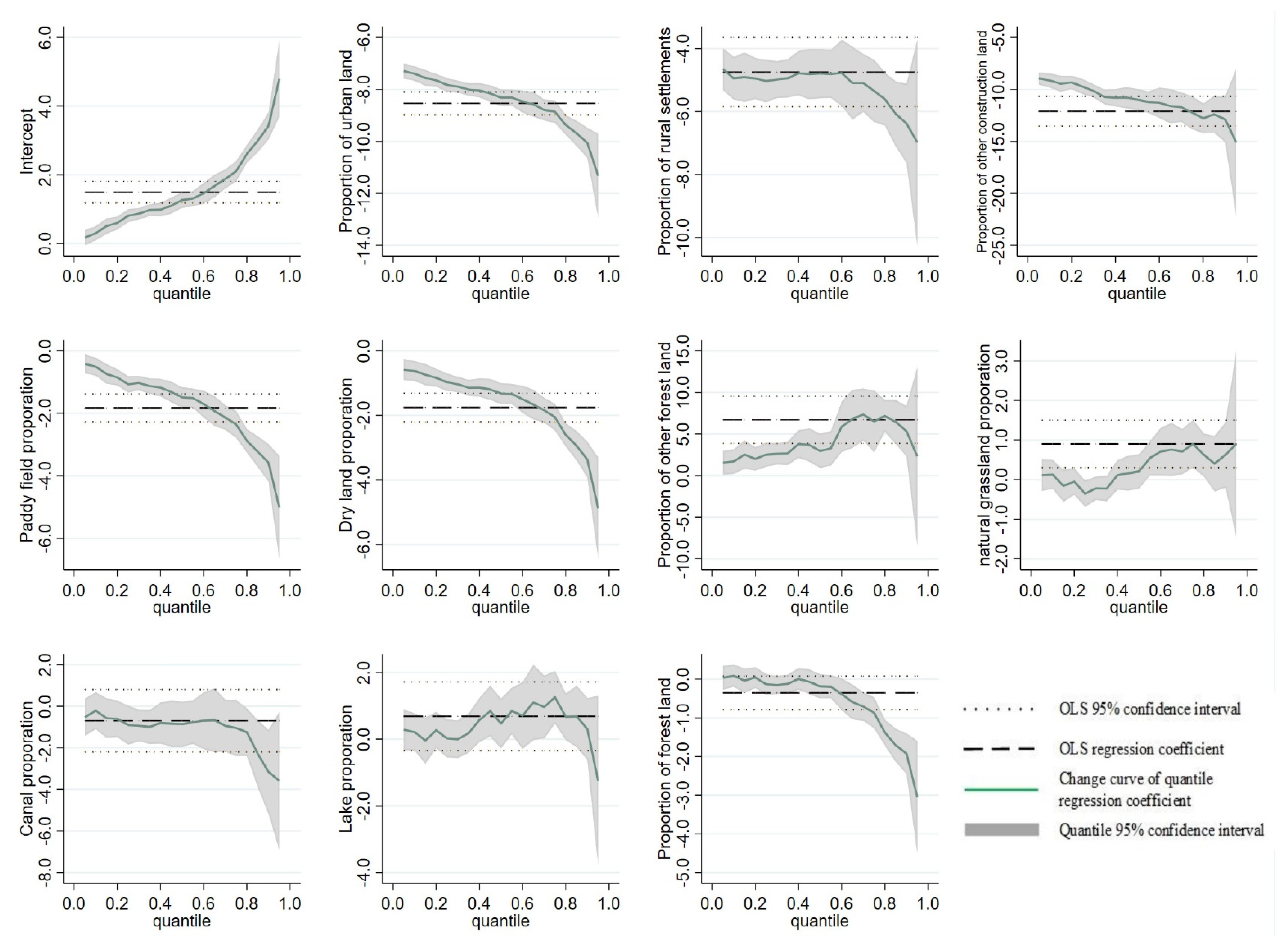
| Primary Ecological Service | Secondary Ecological Services | Cultivated Land | Woodland | Grassland | Water | Unused Land | Construction Land |
|---|---|---|---|---|---|---|---|
| Regulation service | Gas regulation | 480.85 | 3365.95 | 769.36 | 0 | 0 | 0 |
| Climate regulation | 855.91 | 2596.59 | 856.53 | 442.38 | 0 | 0 | |
| Water conservation | 577.02 | 3077.44 | 769.36 | 19,618.68 | 28.85 | 0 | |
| Waste disposal | 1577.19 | 1259.83 | 1259.83 | 17,502.94 | 9.62 | 0 | |
| Support services | Soil formation and protection | 1404.08 | 3750.63 | 1875.32 | 9.62 | 19.23 | 0 |
| Biodiversity conservation | 682.81 | 3135.14 | 1048.25 | 2394.63 | 326.98 | 0 | |
| Supply service | Food production | 961.7 | 96.17 | 288.51 | 96.17 | 9.62 | 0 |
| Raw material | 96.17 | 2500.42 | 48.08 | 9.62 | 0 | 0 | |
| Cultural Services | Entertainment | 9.62 | 1230.98 | 38.47 | 4173.78 | 9.62 | 0 |
| Land Use Type | Cultivated Land | Woodland | Grassland | Water | Construction Land | Unused Land | |
|---|---|---|---|---|---|---|---|
| Area (km2) | 2000 Year | 638,571 | 938,340 | 341,406 | 57,877 | 47,197 | 21,814 |
| 2005 Year | 632,019 | 939,466 | 339,984 | 59,481 | 52,900 | 21,585 | |
| 2010 Year | 627,056 | 939,880 | 339,431 | 59,925 | 57,453 | 21,787 | |
| 2015 Year | 619,095 | 937,085 | 339,253 | 61,011 | 68,015 | 21,846 | |
| 2020 Year | 607,803 | 940,496 | 327,807 | 63,609 | 82,884 | 21,766 | |
| Area change | 2000–2005 (km2) | −6552 | 1126 | −1422 | 1604 | 5703 | −229 |
| 2000–2005 (%) | −1.03% | 0.12% | −0.42% | 2.77% | 12.08% | −1.05% | |
| 2005–2010 (km2) | −4963 | 414 | −553 | 444 | 4553 | 202 | |
| 2005–2010 (%) | −0.79% | 0.04% | −0.16% | 0.75% | 8.61% | 1.33% | |
| 2010–2015 (km2) | −7961 | −2795 | −178 | 1086 | 10,562 | 59 | |
| 2010–2015 (%) | −1.27% | −0.30% | −0.05% | 1.81% | 18.38% | 0.15% | |
| 2015–2020 (km2) | −11,292 | 3411 | −11,446 | 2598 | 14,869 | −80 | |
| 2015–2020 (%) | −1.82% | 0.36% | −3.37% | 4.26% | 21.86% | −0.40% | |
| 2000–2020 (km2) | −30,768 | 2156 | −13,599 | 5732 | 35,687 | 3 | |
| 2000–2020 (%) | −4.82% | 0.23% | −3.98% | 9.90% | 75.61% | 0.01% | |
| Land Use Type | Cultivated Land | Woodland | Grassland | Water | Construction Land | Unused Land | Total | |
|---|---|---|---|---|---|---|---|---|
| ESV (100 million yuan) | 2000 Year | 4243.53 | 19,717.48 | 2374.04 | 2560.93 | 0 | 8.81 | 28,904.79 |
| 2005 Year | 4199.99 | 19,741.14 | 2364.15 | 2631.90 | 0 | 8.72 | 28,945.90 | |
| 2010 Year | 4167.01 | 19,749.84 | 2360.30 | 2651.55 | 0 | 8.88 | 28,937.58 | |
| 2015 Year | 4114.10 | 19,691.11 | 2359.07 | 2699.60 | 0 | 8.85 | 28,872.73 | |
| 2020 Year | 4039.06 | 19,762.78 | 2279.47 | 2814.56 | 0 | 8.84 | 28,904.72 | |
| ESV Change | 2000–2005 | −43.54 | 23.66 | −9.89 | 70.97 | 0 | −0.09 | 41.11 |
| 2000–2005 (%) | −1.03% | 0.12% | −0.42% | 2.77% | 0 | −1.05% | 0.14% | |
| 2005–2010 | −32.98 | 8.70 | −3.85 | 19.65 | 0 | 0.16 | −8.32 | |
| 2005–2010 (%) | −0.79% | 0.04% | −0.16% | 0.75% | 0 | 1.81% | −0.03% | |
| 2010–2015 | −52.90 | −58.73 | −1.24 | 48.05 | 0 | −0.02 | −64.84 | |
| 2010–2015 (%) | −1.27% | −0.30% | −0.05% | 1.81% | 0 | −0.26% | −0.22% | |
| 2015–2020 | −75.04 | 71.68 | −79.59 | 114.96 | 0 | −0.02 | 31.98 | |
| 2015–2020 (%) | −1.82% | 0.36% | −3.37% | 4.26% | 0 | −0.18% | 0.11% | |
| 2000–2020 | −204.46 | 45.30 | −94.56 | 253.63 | 0 | 0.03 | −0.07 | |
| 2000–2020 (%) | −4.82% | 0.23% | −3.98% | 9.90% | 0 | 0.30% | 0.00% | |
| Ecosystem Service Function | Gas Regulation | Climate Regulation | Water Conservation | Soil Formation and Protection | Waste Disposal | Biodiversity Conservation | Food Production | Raw Material | Entertainment | Total | |
|---|---|---|---|---|---|---|---|---|---|---|---|
| ESV (100 million yuan) | 2000 | 3728.13 | 3301.07 | 4654.92 | 5057.19 | 3632.64 | 3881.46 | 808.63 | 2424.63 | 1416.13 | 28,904.79 |
| 2005 | 3727.67 | 3297.88 | 4684.97 | 5049.56 | 3650.00 | 3882.79 | 802.18 | 2426.76 | 1424.09 | 28,945.90 | |
| 2010 | 3726.26 | 3294.44 | 4691.68 | 5043.12 | 3649.78 | 3881.25 | 797.34 | 2427.30 | 1426.40 | 28,937.58 | |
| 2015 | 3712.89 | 3280.69 | 4699.65 | 5021.14 | 3652.49 | 3869.47 | 789.46 | 2419.55 | 1427.40 | 28,872.73 | |
| 2020 | 3710.13 | 3271.23 | 4745.79 | 4996.63 | 3670.03 | 3866.67 | 775.88 | 2426.47 | 1441.89 | 28,904.72 | |
| ESV Change | 2000–2005 | −0.45 | −3.19 | 30.05 | −7.63 | 17.37 | 1.33 | −6.45 | 2.13 | 7.96 | 41.11 |
| 2000–2005 (%) | −0.01% | −0.10% | 0.65% | −0.15% | 0.48% | 0.03% | −0.80% | 0.09% | 0.56% | 0.14% | |
| 2005–2010 | −1.41 | −3.44 | 6.71 | −6.44 | −0.22 | −1.53 | −4.84 | 0.54 | 2.30 | −8.32 | |
| 2005–2010 (%) | −0.04% | −0.10% | 0.14% | −0.13% | −0.01% | −0.04% | −0.60% | 0.02% | 0.16% | −0.03% | |
| 2010–2015 | −13.38 | −13.75 | 7.97 | −21.99 | 2.70 | −11.79 | −7.87 | −7.75 | 1.01 | −64.84 | |
| 2010–2015 (%) | −0.36% | −0.42% | 0.17% | −0.44% | 0.07% | −0.30% | −0.99% | −0.32% | 0.07% | −0.22% | |
| 2015–2020 | −2.76 | −9.46 | 46.14 | −24.50 | 17.54 | −2.80 | −13.58 | 6.92 | 14.49 | 31.98 | |
| 2015–2020 (%) | −0.07% | −0.29% | 0.98% | −0.49% | 0.48% | −0.07% | −1.72% | 0.29% | 1.02% | 0.11% | |
| 2000–2020 | −18.00 | −29.84 | 90.88 | −60.56 | 37.39 | −14.79 | −32.75 | 1.84 | 25.76 | −0.07 | |
| 2000–2020 (%) | 0.00 | −0.01 | 0.02 | −0.01 | 0.01 | 0.00 | −0.04 | 0.00 | 0.02 | 0.00 | |
| Explanatory Variable | OLS | Quantile | |||||
|---|---|---|---|---|---|---|---|
| 0.1 | 0.3 | 0.5 | 0.7 | 0.9 | |||
| Intercept | 1.494 *** | 0.298 *** | 0.866 *** | 1.264 *** | 1.879 *** | 3.420 *** | |
| −0.159 | −0.099 | −0.13 | −0.148 | −0.196 | −0.321 | ||
| Living land | Proportion of urban land | −8.535 *** | −7.392 *** | −7.891 *** | −8.316 *** | −8.790 *** | −10.060 *** |
| −0.224 | −0.139 | −0.184 | −0.208 | −0.277 | −0.452 | ||
| Proportion of rural settlements | −4.749 *** | −4.947 *** | −4.989 *** | −4.793 *** | −5.098 *** | −6.382 *** | |
| −0.559 | −0.347 | −0.457 | −0.518 | −0.69 | −1.127 | ||
| Production land | Proportion of other construction land | −12.105 *** | −9.135 *** | −10.140 *** | −10.974 *** | −11.703 *** | −12.873 *** |
| −0.727 | −0.451 | −0.594 | −0.674 | −0.897 | −1.465 | ||
| Paddy field proportion | −1.827 *** | −0.507 *** | −1.027 *** | −1.489 *** | −2.133 *** | −3.582 *** | |
| −0.227 | −0.141 | −0.186 | −0.21 | −0.28 | −0.457 | ||
| Dry land proportion | −1.757 *** | −0.622 *** | −1.038 *** | −1.322 *** | −1.843 *** | −3.369 *** | |
| −0.226 | −0.14 | −0.185 | −0.21 | −0.279 | −0.456 | ||
| Proportion of other forest land | 6.704 *** | 1.687 * | 2.623 ** | 2.966 ** | 7.334 *** | 5.326 * | |
| −1.444 | −0.895 | −1.18 | −1.338 | −1.781 | −2.909 | ||
| Ecological land | Natural grassland proportion | 0.902 *** | 0.133 | −0.214 | 0.209 | 0.709 * | 0.626 |
| −0.306 | −0.19 | −0.25 | −0.284 | −0.377 | −0.616 | ||
| Canal proportion | −0.694 | −0.207 | −0.93 | −0.865 | −0.934 | −3.152 ** | |
| −0.767 | −0.475 | −0.627 | −0.71 | −0.945 | −1.544 | ||
| Lake proportion | 0.689 | 0.219 | 0 | 0.47 | 0.966 | 0.308 | |
| −0.524 | −0.325 | −0.428 | −0.486 | −0.646 | −1.056 | ||
| Proportion of forest land | −0.355 | 0.091 | −0.15 | −0.185 | −0.708 *** | −1.926 *** | |
| −0.221 | −0.137 | −0.181 | −0.205 | −0.273 | −0.445 | ||
Publisher’s Note: MDPI stays neutral with regard to jurisdictional claims in published maps and institutional affiliations. |
© 2022 by the authors. Licensee MDPI, Basel, Switzerland. This article is an open access article distributed under the terms and conditions of the Creative Commons Attribution (CC BY) license (https://creativecommons.org/licenses/by/4.0/).
Share and Cite
Zhao, C.; Xiao, P.; Qian, P.; Xu, J.; Yang, L.; Wu, Y. Spatiotemporal Differentiation and Balance Pattern of Ecosystem Service Supply and Demand in the Yangtze River Economic Belt. Int. J. Environ. Res. Public Health 2022, 19, 7223. https://doi.org/10.3390/ijerph19127223
Zhao C, Xiao P, Qian P, Xu J, Yang L, Wu Y. Spatiotemporal Differentiation and Balance Pattern of Ecosystem Service Supply and Demand in the Yangtze River Economic Belt. International Journal of Environmental Research and Public Health. 2022; 19(12):7223. https://doi.org/10.3390/ijerph19127223
Chicago/Turabian StyleZhao, Chong, Pengnan Xiao, Peng Qian, Jie Xu, Lin Yang, and Yixiao Wu. 2022. "Spatiotemporal Differentiation and Balance Pattern of Ecosystem Service Supply and Demand in the Yangtze River Economic Belt" International Journal of Environmental Research and Public Health 19, no. 12: 7223. https://doi.org/10.3390/ijerph19127223
APA StyleZhao, C., Xiao, P., Qian, P., Xu, J., Yang, L., & Wu, Y. (2022). Spatiotemporal Differentiation and Balance Pattern of Ecosystem Service Supply and Demand in the Yangtze River Economic Belt. International Journal of Environmental Research and Public Health, 19(12), 7223. https://doi.org/10.3390/ijerph19127223






